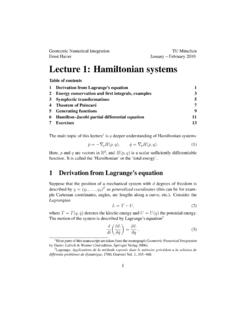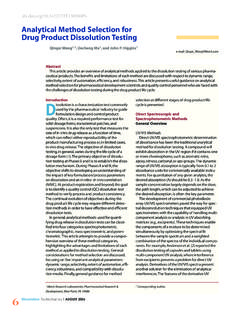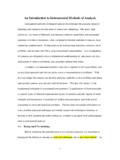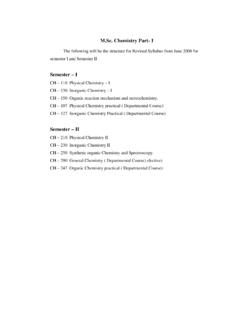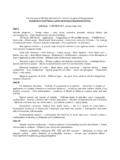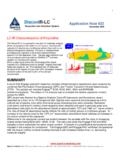Transcription of Quantitative Infrared Methods for the Measurement …
1 3600 Macromolecules 1989, 22, 3600-3606 Quantitative Infrared Methods for the Measurement of crystallinity and Its Temperature dependence : polyethylene H. Hagemam+ and R. G. Snyder* Department of Chemistry, University of California, Berkeley, California 94720 A. J. Peacock and L. Mandelkern Institute of Molecular Biophysics and Department of Chemistry, Florida State University, Tallahasee, Florida 32306. Received October 25, 1988; Revised Manuscript Received January 30, 1989 ABSTRACT Vibrational spectroscopic Methods are widely used to characterize semicrystalline polymers in terms of crystallinity .
2 The temperature coefficient of crystallinity , an important and fundamental quantity, is seldom determined for lack of a sensitive method. In this paper, we describe an Infrared approach to the Measurement of the temperature coefficient of crystallinity . We start from the well-known observation that the integrated intensities of the bands in the spectrum of a semicrystalline polymer change with temperature. It is also known, though less appreciated, that only part of the change is due to changes in crystallinity , the remaining part being due to changes in the intrinsic intensity of the bands.
3 We outline a method for separating these overlapping effects. The method has been applied to a variety of semicrystalline polyethylene samples. The temperature coefficients are found to be highly dependent both on the temperature and on the morphology of the sample. In addition we report crystallinity measurements on a solution crystallized low molecular weight (A& = 13 600) sample, discuss the origin of an apparent anomalous temperature dependence of band intensity cited in the literature, and offer Quantitative evidence that the temperature dependence of specific volume is, at temperatures above 0 C, largely determined by partial melting.
4 I. Introduction Infrared and Raman spectra are sensitive to the con- formation and packing of chain molecules, and this sen- sitivity has been widely exploited to characterize semi- crystalline polymers in terms of their crystallinity . An important related quantity that is rarely measured is the temperature coefficient of crystallinity . Vibrational spectroscopy has not been widely used for this measure- ment because of the difficulties in interpreting the tem- perature changes that are observed. In the Infrared , it is known that a change in the temperature of a liquid or solid sample affects the shape and the intensities of the bands and that the magnitudes of the effects are dependent on the temperature as well as on the physical state of the system.
5 For the polymethylene chain in condensed phases, we have shown quantitatively that these effects are very large in the Infrared , even at ambient temperatures . To measure the temperature dependence of crystallinity in chain-molecule systems, it is therefore necessary to sep- arate the effect on the spectrum of temperature per se from the effect of structural change. The high sensitivity of Infrared spectroscopy, relative to other techniques, provides an incentive to develop Methods for such measurements. In some ways, vibrational spectroscopy is uniquely suited for this. Characteristic bands can be associated with the ordered fraction and with the disordered fraction, and these bands normally have comparable intrinsic intensities.
6 The bands remain clearly distinguishable over a wide range of temperatures and for different phases of the sample. In this paper, we discuss the determination of crystal- linity and its temperature dependence for semicrystalline polymers by means of Infrared spectroscopy. The proce- dures are illustrated for a number of polyethylene (PE) samples that differ in crystallinity . The measurements reported here do not represent a comprehensive study of all the structural and morphological variations that can * To whom correspondence should be addressed. Present address: Groupe PCS, University of Geneva, 1211 Ge- neve 4, Switzerland.
7 0024-929718912222-3600$ be attained in polyethylene but demonstrate what is possible, the procedures involved, and the sensitivities that may be achieved. On the other hand, some of the prelim- inary results are interesting in their own right. 11. Approaches tensity, I, of a band is defined as From the experimental point of view, the Infrared in- where b is the path length, p is the density of the sample, and A, is the absorbance at frequency v (in wavenumbers). In our discussion, the term intensity , unless otherwise indicated, will refer to integrated intensity as defined in eq 1. Nearly all our measurements have been made on poly- mer films sandwiched between KBr or CsBr windows.
8 In that case, a change of temperature leaves the product bp, which appears in eq 1, unchanged since, in the absence of lateral movement of the film, the number of molecules in the Infrared beam remains constant. Therefore, the product bp need not be known in determining the tem- perature coefficient of intensity. If temperature is to be a variable, integrated Infrared intensities are to be preferred to peak heights for quan- titive measurements because they are less subject to tem- perature effects. The problem with peak heights is that they depend on band shapes, and band shapes are mark- edly affected by dynamic factors that affect vibrational relaxation2 as well as by local inhomogeneities in the microstructure of the system.
9 Therefore, for our purposes, peak height is an unsatisfactory measure of band intensity. Although integrated intensities are less dependent on temperature than the peak heights, they are by no means temperature independent. The reasons for the dependence are not obvious. Elementary considerations indicate that, for harmonic vibrational modes in the absence of signifi- cant intermolecular interaction, integrated intensities should be essentially independent of temperature and This problem of the temperature dependence of 0 1989 American Chemical Society Macromolecules, Vol. 22, No. 9, 1989 intensities for the condensed state has received very little attention.
10 Some measurements on small molecules in the liquid phase have been reported, and these show that in- trinsic intensities generally decrease somewhat as tem- perature increase^.^ Earlier, we reported on the temperature dependence of the Infrared intensities of the polymethylene chain from 7 to 370 K.' This work appears to stand alone as the sole attempt to determine the temperature dependence of the intrinsic intensities of a simple system in the solid state over a wide temperature region. Our measurements on the polymethylene chain revealed large changes in integrated intensities with temperature over a wide temperature region.
